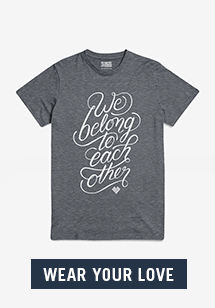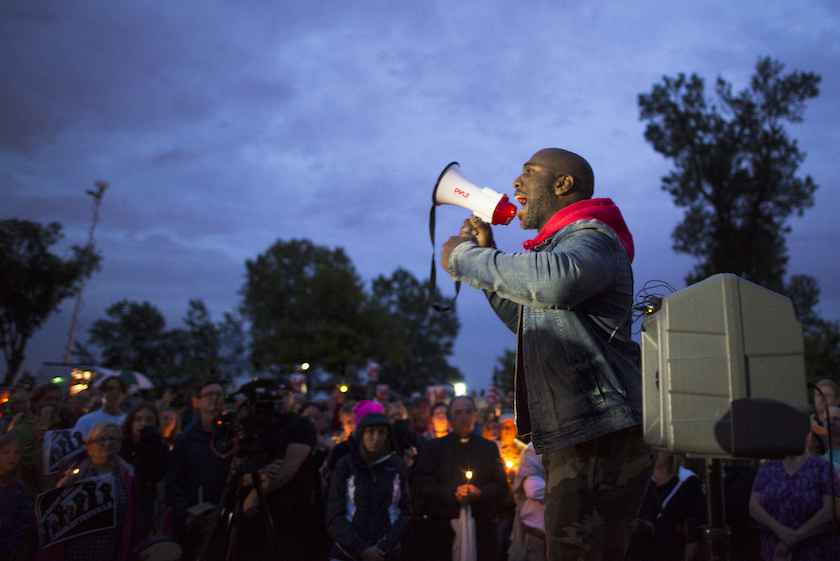Inevitably news of the racist acts of terrorism will fade in the next couple days. People who had the Monday morning exchange with their co-workers, “Did you see what happened in Charlottesville?” will go back to business as usual. I’ve seen this happen one too many times as horror and tragedy is perpetrated in our country and in our world.
But this is not your only option. And I’m begging you to please do something different this time.
Up until three weeks ago, Charlottesville was my home. On Saturday, I watched in pain as white nationalists purposefully incited violence and terror in a community that I love. Since Saturday morning, I’ve experienced a wide range of emotions—anger, grief, sadness, fear, worry.
I’ve seen post after post of people expressing that they don’t know what to do or say in response. While there are many ways to respond to Saturday’s acts of terror, I’d like to ask you to consider this one.
Learn to love your friends of color well.
Before I dig into ways you can love your friends of color well, I need to offer some important disclaimers:
- I do not and will never speak for every person of color. I am a biracial (Black and white) woman. As such, I get many privileges of being fair skinned. I acknowledge that and I wrestle with that regularly. But even if I was “fully Black,” I still would not speak for every Black individual. There is no one monolithic Black experience.
- This is not meant to be an exhaustive commentary on my thoughts of racism in America or even about the many levels of pain and trauma experienced because of the actions of white nationalists in Charlottesville. I hope to simply offer a starting point so that we can have conversations in a way that can move us toward a place of acceptance and love. Please feel free to add your thoughts in the comments and talk to me about what I’ve said here.
- Finally, my thoughts here will not be perfectly articulated, but give me some grace and feel free to reach out.
Let’s get on with it then.
This might seem like a no brainer, but it is important to understand that racist acts trigger a response in people of color. It doesn’t have to be the type of racism that makes headlines, but if you’re a person of color, it’s hard to not have some level of reaction to actions or words that communicate hatred about who you are.
Step #1 – Let us react.
Our reactions will not be the same. I spent Saturday crying, kickboxing, yelling, and calmly cleaning my apartment. Others might not have shed a tear. All of that is OK. As I said before, we don’t all share one experience, so we’re going to react differently. We’re also different human beings, who have different personalities and ways of expressing ourselves.
Step #2 – Give us the freedom to react and to express ourselves in the ways we need to in the moment.
I know that my reactions are not always consistent. I do tend to follow a pattern of rage and tears, but sometimes I’m fine in an hour and other times it takes days. Don’t expect your friends of color to react the same way each time there’s another headline about white supremacy. And don’t expect us to show us our reaction to every single act of racism. Newsflash: we could give you daily examples of acts of racism, but sometimes we don’t want to talk about it with you… or at all.

Now this is where it gets complicated…
Step #3 – You need to say something, but you need to be smart with your words.
You have no idea how much pain is caused by silence. You may mean well and just be unsure of what to say. But by staying silent, you communicate that what happened is acceptable. If in doubt, here are a couple words that go a long way:
“I’m sorry.”
You don’t have to give a lengthy monologue about the history of racial oppression in America—in fact, please don’t. But by simply saying “I’m sorry,” you’re acknowledging that a wrong has occurred, and you’re expressing solidarity. You’re also acknowledging that our pain is real.
This is important. Your friend of color can probably tell you about the many times she’s had to justify feeling marginalized or threatened. We shouldn’t have to make you believe us when we say we experience pain. If your friend breaks her arm, you don’t ask her why it hurts.
So check in. When days like Saturday happen, reach out to your friends and ask them how they’re doing or say I’m sorry. And then listen.

This is not the space to talk about how you’re shocked about what happened or can’t believe the images you’re seeing are from 2017. Your friend of color isn’t shocked. She’s lived her life navigating a world that in a variety of different ways tells her she’s unwanted and unacceptable. When you say you’re shocked, what we hear is that up until whatever most recent acts of racism occurred, you thought we lived in a post-racial society. Something we’ve probably been trying to tell you isn’t true for a while.

As you listen, please don’t get defensive. By expressing our frustrations with racism, white supremacy, or the specific injustice of the day, we are not attacking you. We’re most likely not even blaming you for what we’ve experienced. We’re just trying to be vulnerable with a friend about our feelings. Our anger is targeted at people who perpetuate a system of hatred and injustice… and at specific people who have committed acts of racial terrorism.
Which leads me to my final points. After acts of terror and racism, there is a lot to process and to discuss, and it is important that we have those conversations. But sometimes your friends of color need a break. It’s exhausting to have to live an experience and simultaneously educate others about your experience.
Step #4 – Surround yourself with people who are different than you.
I can guarantee your friend of color has been told by a friend/date/casual acquaintance, “My best friend in elementary school was Black,” or some variation of that. This phrase falls into the category of things to never say. (I can give you some others, but that’s another blog for another time.) It suggests because you had a relationship with one person of color that you understand us all—when you may not have even understood that one friend at all.
We don’t want to be in your collection of multi-ethnic relationships, but we do want you to be intentional about whom you befriend. No one wants to be the friend who someone goes to all the time about one specific thing. It’s exhausting, and frankly makes you feel like the only part of you that is appreciated is the narrow aspect your friend is interested in.
As you want to discuss and process, talk to different friends about it. Some conversations might be better suited to have with your friends who aren’t people of color. (Yes, you can have good conversations about racism that don’t involve a person of color. Though please don’t think that you can solve the issues of racism in America by yourselves. We’re not a problem to be figured out, and we don’t need someone to speak for us.) And make more than one Black friend. You’ll start to see that there is no one Black experience, and you’ll gain another great friend.

Step #5 – Take the time to educate yourself.
Like I said, no friend wants to be the one who answers all of your questions. We live in a wonderful world where information is constantly accessible at our fingertips. Take time to read books and articles that discuss different views than your own. I’ve included a small list of some below that are powerful works about how to think about race. (Please feel free to add to it in the comments.)
As you learn, you’ll start to realize that racism doesn’t manifest itself in the ways you may think. One of my frustrations over the last couple days has been that people denounced the violent actions of white nationalists in Charlottesville while having in the past turned a blind eye to educational inequalities in our country, disparate treatment in drug sentencing laws, or unbalanced police responses to communities of color.
If you say you are against white supremacy and racism, you need to recognize the subversive ways racism is woven into many different parts of our society. You can’t pick and choose what racist ideologies are acceptable to you. There are no half measures in condemning racial oppression.
Finally, try not to forget. I know this is hard. Internalizing an experience that is not our own is never easy or natural, but we all must do it at times. It will be so easy to move on this week and to think only of this weekend’s horror as a hashtag. But please try to internalize the anger and indignation you felt. Channel it into conversations with your family and friends. Add a book to your summer reading list. Donate to an organization committed to racial justice. The chains of hatred are not easily broken, but we can try to break them one link at a time.
We, your friends of color, don’t have the luxury of forgetting. We’ll bear the emotional and, some of us, physical scars of this hatred. And we’ll keep pressing on towards justice because we have to. Our lives and the lives of those we love depend on it. So please, remember. Stand with us. Give us a shoulder to lean on when we’re tired. And when we are utterly flattened by the weight of the horror in this world, stand in the gap for us until we can get back on our feet. We will get back up, but we shouldn’t have to do it alone.
Things to Read
*This list is a very small sampling of the incredible thoughts of Black authors and other authors of color. Please add to it!*
- Between the World and Me by Ta-Nehisi Coates
- Just Mercy by Bryan Stevenson
- The New Jim Crow by Michelle Alexander
- Reconciliation Blues by Edward Gilbreath
- Dream with Me by John Perkins
- “White” is NOT a Four Letter Word
- 4 Reasons Why You Shouldn’t Teach Your Kids to be Colorblind
This post originally appeared on Amber Strickland’s blog, Strictly Speaking. Reposted with the author’s permission. You can follow Amber on Twitter here.


